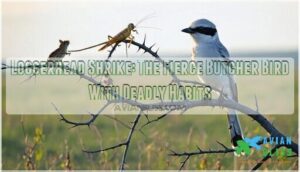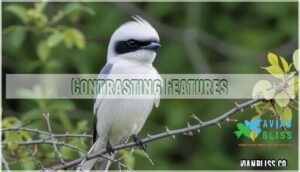This site is supported by our readers. We may earn a commission, at no cost to you, if you purchase through links.

This robin-sized predator earns its "butcher bird" nickname through a chilling hunting method—it impales prey on thorns and barbed wire like a medieval executioner.
The loggerhead shrike compensates for its lack of powerful talons by using these natural spikes to anchor victims while tearing them apart.
With a 65% hunting success rate, it targets insects, rodents, small birds, and lizards from elevated perches, creating macabre food storage sites that reveal the darker side of nature’s efficiency.
Table Of Contents
- Key Takeaways
- Loggerhead Shrike Habitat
- Physical Characteristics
- Diet and Foraging
- Behavior and Socialization
- Conservation Status
- Frequently Asked Questions (FAQs)
- Are loggerhead shrikes aggressive?
- What is the difference between northern shrike and loggerhead shrike?
- Why do loggerhead shrikes impale their prey?
- Where do loggerhead shrikes live?
- Why is the shrike called the butcher bird?
- How long do loggerhead shrikes typically live?
- Do loggerhead shrikes migrate seasonally?
- Can loggerhead shrikes mimic other bird calls?
- How many broods do loggerhead shrikes raise annually?
- Are loggerhead shrikes susceptible to specific diseases or parasites?
- Conclusion
Key Takeaways
- You’ll spot these "butcher birds" by their black mask and hooked beak – they’re robin-sized songbirds that look deceptively innocent but are actually fierce predators with a 65% hunting success rate
- They compensate for lacking powerful talons by impaling prey on thorns and barbed wire – this gruesome storage method lets them tear apart insects, rodents, small birds, and lizards using leverage
- You’ll find them in open grasslands and scrublands across North America – they hunt from elevated perches like fence posts, preferring areas with scattered thorny vegetation for their macabre food storage sites
- These birds face serious conservation challenges due to habitat loss and environmental changes – their populations have been declining since the 1940s, making protection efforts critical for their survival
Loggerhead Shrike Habitat
If you’re curious about where loggerhead shrikes make their homes, you’ll find these "butcher birds" in open grasslands and scrublands with scattered perches.
These notorious "butcher birds" stake out prime hunting real estate in wide-open grasslands and thorny scrublands.
They’ve adapted to hunt from fence posts and thorny bushes, using these spots to survey their territory and impale their prey, which is a key behavior of these "loggerhead shrikes".
Geographical Distribution
Where can you find this migratory bird across the globe? The loggerhead shrike ranges throughout most of North America from southern Canada to southern Mexico, though its global range has been shrinking.
The distribution of the northern subspecies ranges from north to eastern North America; however, its range has been diminishing since the 1940s. Population segments vary dramatically across regions, with uneven and local distribution, particularly in the northeastern U.S.
Migration patterns show these North American birds make short-distance movements, with regional abundance strongest in grassland habitats throughout their bird habitat range.
These birds are known to impale their prey on thorns and barbed wire.
Preferred Ecosystems
You’ll find these fierce North American birds thriving in open grasslands, short-grass pastures, and agricultural fields.
Loggerhead shrikes prefer habitats with scattered shrubs, elevated perches like fence posts, and well-spaced thorny vegetation.
Unlike ocean-dwelling species, their bird habitat includes golf courses, cemeteries, and desert scrublands where bird behavior and diet focus on terrestrial hunting opportunities and exhibit unique characteristics in these environments.
Unique Habitat Adaptations
You’ve found the perfect resource! Loggerhead shrikes thrive in open grasslands and agricultural areas with scattered perches.
This notorious butcher bird showcases remarkable adaptations:
- Elevated hunting perches for scanning prey
- Hooked beak with falcon-like notch for quick kills
- Impaling prey on thorns compensates for lack of talons
- Strategic territory selection with foraging areas and nesting sites
These bird behavior specialists excel at turning limitations into strengths through clever habitat use. Sadly, the species has faced significant population decline in recent decades.
Physical Characteristics
Looking at a loggerhead shrike, you’ll notice its striking black-and-white pattern that makes it instantly recognizable in the field.
This medium-sized songbird combines the appearance of an innocent perched bird with the predatory features of a miniature raptor.
Contrasting Features
You’ll notice the loggerhead shrike doesn’t look like your typical butcher bird at first glance.
This songbird sports a striking black mask across its eyes, contrasting sharply with gray upperparts and white underparts.
Unlike the Turtle vs. Tortoise debate where differences are subtle, the shrike’s contrasting features make it unmistakable.
Its hooked beak immediately signals this carnivorous bird’s predatory nature, setting it apart from other songbirds completely.
Size and Plumage
You’ll recognize a loggerhead shrike by its robin-sized frame, measuring eight to ten inches with a twelve-inch wingspan.
Adult size remains consistent year-round, while juvenile plumage displays more muted gray-brown tones compared to adults’ striking black and white patterns.
This songbird’s color variations include regional differences in gray intensity.
Weight differences between males and females are minimal, typically ranging from 1.2 to 2.8 ounces, making bird identification easier for observers, based on the bird’s overall size.
Beak Shape and Size
You’ll notice the loggerhead shrike’s hooked beak isn’t your typical songbird feature—it’s more raptor-like for good reason.
This powerful tool showcases remarkable Beak Adaptation for its carnivorous lifestyle, demonstrating Feeding Efficiency through Evolutionary Pressures that shaped this bird of prey.
Key beak characteristics include:
- Sharp hook – Tears flesh like a miniature eagle
- Robust structure – Handles struggling prey with ease
- Precise grip – Enables accurate Prey Specialization targeting
- Moderate Beak Dimorphism** – Males slightly larger for dominance
This shrike bird proves that effective bird identification often starts with understanding how bird diet shapes anatomy, making bird feeding observations essential for species recognition.
Diet and Foraging
You’ll find that loggerheads aren’t after fish like most birds of prey.
Instead, they’re skilled hunters targeting insects, small mammals, amphibians, reptiles, and even other birds with their hooked beaks and razor-sharp hunting instincts.
Primary Prey Items
You’ll discover that loggerhead shrikes aren’t picky eaters when hunting.
These versatile predators feast on insects like grasshoppers and beetles through skilled insect consumption. They also target small mammals including mice and shrews.
Bird predation occurs with smaller songbirds, while their reptile diet includes lizards and snakes. Amphibian prey like frogs round out their menu.
Shrikes’ taste for insects sometimes leads to the use of various trapping methods to control local populations. This shrike bird demonstrates remarkable dietary flexibility as an effective bird of prey.
Predatory Techniques
How do you spot a loggerhead shrike on the hunt? You’ll witness nature’s precision predator employing calculated hunting strategies that rival any apex hunter.
These "butcher birds" combine lightning-fast strike speed with remarkable sensory adaptations to dominate their territory through wildlife research and conservation efforts.
- Perch-and-Wait Strategy: Stakes out high vantage points like fence posts and telephone wires for maximum surveillance coverage
- Lightning Strike Speed: Swoops down at prey with explosive bursts reaching 25+ mph in seconds
- Enhanced Sensory Adaptations: Uses exceptional eyesight to detect movement from 100+ feet away
- Territory Patrol Method: Systematically hunts across defined areas, memorizing productive hunting spots
- Weather-Responsive Hunting: Adjusts techniques based on wind conditions and prey availability patterns
Wildlife conservation programs study these impaling mechanics to better understand endangered species behavior and support bird conservation initiatives.
Their diet often includes small prey items.
Impaling Prey Behavior
You’ll witness nature’s most macabre pantry when observing loggerhead shrikes at work.
These clever predators use thorns, barbed wire, and sharp branches as natural skewers for prey storage. This impaling method serves multiple nutritional benefits – tenderizing tough prey while creating accessible food caches.
Wildlife research reveals this tool use demonstrates remarkable shrike evolution, making these birds fascinating subjects for environmental education programs focused on wildlife conservation behaviors.
Shrikes, like other birds, exhibit varied feeding activity patterns, which is a key aspect of their behavioral adaptations.
Behavior and Socialization
If you’ve ever wondered about nature’s most notorious serial killer, you’ll be fascinated by the loggerhead shrike’s complex social dynamics.
These seemingly innocent songbirds display surprisingly aggressive behaviors that would make even hardened predators take notice, showcasing their complex social dynamics.
Aggressive Behavior
You’ll witness territorial defense reach peak intensity when loggerheads stake their claims.
These birds transform from patient hunters into fierce warriors, using dominance displays to ward off rivals. Predatory aggression drives their impaling motivation, while intraspecific conflict becomes routine during breeding season.
Understanding this behavior requires acknowledging that nesting season triggers heightened aggression.
- Razor-sharp talons slash through air as rivals clash over prime hunting territories
- Piercing alarm calls echo across grasslands when intruders dare approach their domain
- Lightning-fast strikes target competitors with surgical precision during aggressive encounters
- Unwavering stare-downs precede explosive battles that determine territorial ownership
Interaction With Other Species
You’ll notice the shrike’s territorial nature creates complex species interaction patterns throughout its ecosystem.
These aggressive birds don’t play well with others, often driving away potential competitors from prime hunting spots.
| Interaction Type | Target Species | Outcome |
|---|---|---|
| Competition Dynamics | Other shrikes, raptors | Territory displacement |
| Predator Avoidance | Hawks, owls | Defensive mobbing behavior |
| Ecosystem Impact | Songbirds, rodents | Population control through predation |
| Interspecies Communication | Warning calls | Alert system for wildlife conservation efforts |
Unlike marine species that form symbiotic relationships, shrikes maintain hostile relationships with most neighbors, creating ripple effects that influence entire marine life-like food webs on land.
Courtship and Mating
During peak mating season, shrikes transform into elaborate performers. Males perform erratic flight displays, dancing rapidly up and down while chasing potential mates. Courtship involves males offering food to females, who accept prey when forming pair bonds.
Mating Rituals and Behavior:
- Females accept food and respond with begging calls and wing-flutters when ready to pair
- Both sexes collaborate in nest building using twigs, grass, and soft materials
- Primarily monogamous, though polygyny occasionally occurs
- Courtship feeding continues throughout incubation and nesting periods
- Nesting begins early spring in dense, thorny shrubs 5-30 feet high
Conservation Status
You’ll find that loggerhead shrikes face serious population declines across much of their range, making conservation efforts critical for their survival.
These fierce little predators need your attention now more than ever as habitat loss and environmental changes threaten their future.
Threats to Population
After watching shrikes tussle over territory, you’ll see their biggest threats aren’t just rivals.
Habitat loss chops their world into fragments, while pollution impact and climate change mess with their food and timing.
Fishing bycatch isn’t a shrike problem, but predation increase and wildlife threats keep their numbers low.
Environmental threats stack up fast—shrikes need a break!
| Threats | Impact |
|---|---|
| Habitat Loss | Fewer nests |
| Pollution Impact | Egg decline |
| Climate Change | Range shift |
| Predation | Chick loss |
| Wildlife threats | Lower survival |
Habitat Preservation
You know, protecting wildlife habitats isn’t just about saving birds from predators.
Nesting Beach Protection helps Loggerhead Shrikes thrive, while smart choices around Coastal Development Impacts and Pollution Mitigation keep their home safe.
Climate Change Effects can be tricky, but Habitat Restoration Efforts and Marine protected areas boost species survival.
Creating reliable water sources is also essential for their survival.
Every step you take supports these fierce birds in their marine habitats.
Protected Areas and Legislation
Under federal ESA Protection, you’ll find critical habitats designated across North America where loggerhead shrikes receive the strongest wildlife protection laws.
International treaties coordinate species conservation efforts between the U.S. and Canada, while funding allocation supports enforcement success.
These thorough wildlife protection measures demonstrate how species preservation works when governments commit resources to species protection through dedicated legislation and habitat management. You can find related wildlife protection products online.
Frequently Asked Questions (FAQs)
Are loggerhead shrikes aggressive?
Like tiny warriors in the hunting arena, you’ll find these predatory songbirds are indeed aggressive hunters that pounce on insects, birds, lizards, and small mammals from elevated perches.
They earn their fearsome reputation by doing so.
What is the difference between northern shrike and loggerhead shrike?
You’ll spot Northern shrikes by their larger size, hooked bills, and black masks extending behind their eyes. Loggerheads are smaller with straight bills and masks stopping at their eyes.
Why do loggerhead shrikes impale their prey?
Seventy percent of loggerhead shrikes’ prey gets impaled alive.
You’ll see them creating "pantries" because they lack powerful talons like hawks.
Impaling compensates for their weakness—storing food on thorns and barbed wire lets them tear apart prey efficiently using leverage.
Where do loggerhead shrikes live?
You’ll find these shrikes across North America’s grasslands and open habitats, from southern Canada down to Mexico.
They thrive in grasslands and other open habitats throughout much of North America, preferring areas with scattered perches for hunting.
Why is the shrike called the butcher bird?
Nature’s master food processor gets creative when building its pantry.
You’ll find shrikes impaling prey on sharp objects like thorns and barbed wire fences, which explains their nickname perfectly.
This brutal storage method lets them feast later when hunting’s tough, and it is a brutal way to store food, allowing them to survive when hunting’s tough.
How long do loggerhead shrikes typically live?
You’ll live about 7-8 years in the wild, though the oldest recorded age was 12 years and 6 months. Some exceptional birds can reach nearly 12 years, proving longevity varies among individuals.
Do loggerhead shrikes migrate seasonally?
Yes, you’ll notice seasonal migration patterns that vary by location. Northern shrikes migrate south of 40°N latitude to avoid snow, while southern populations often stay year-round, creating fascinating overlap zones.
Can loggerhead shrikes mimic other bird calls?
Mimicking bird calls comes naturally to these songbirds.
Loggerhead shrikes include sharp notes and mimicry of other sounds in their vocalizations, though their repertoire isn’t as sophisticated as their Northern Shrike cousins, which include mimicry of other sounds.
How many broods do loggerhead shrikes raise annually?
Like clockwork for these predatory songbirds, you’ll find they typically raise two broods annually.
North Carolina studies show two broods are the norm, while southern populations occasionally manage three broods per season, which can be considered a norm.
Are loggerhead shrikes susceptible to specific diseases or parasites?
These birds face real health challenges that you should know about.
West Nile virus poses a serious threat, causing neurologic symptoms and potential death within days.
This is particularly dangerous in captive breeding programs where it spreads rapidly among vulnerable populations.
Conclusion
Despite appearing harmless, you’ve now discovered that songbirds can be nature’s most ruthless killers.
The loggerhead shrike proves appearances deceive—this masked marauder transforms everyday thorns into medieval torture devices.
You’ll never look at barbed wire the same way, knowing it doubles as this bird’s butcher block.
Through remarkable hunting success and gruesome storage methods, the loggerhead shrike reminds us that survival often requires embracing our darker instincts.












